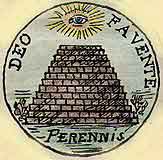sumber : wikipedia klik disini
Sungguh mencengangkan.Annuit cœptis
From Wikipedia, the free encyclopedia

Annuit cœptis (in Anglicized Latin pronounced /ˈænjuːɪt ˈsɛptɨs/) is one of two mottos (the other being Novus ordo seclorum) on the reverse side of the Great Seal of the United States. Taken from the Latin words annuo (nod, approve) and cœpi (begin, undertake), is literally translated as "He approves (or has approved) [our] undertakings".
In 1782, Congress appointed a design artist, William Barton of Philadelphia, to bring a proposal for the national seal.[1] For the reverse, Barton suggested a thirteen layered pyramid underneath the Eye of Providence. The motto which Barton chose to accompany the design was, Deo Favente Perennis, "Enduring by the Favor of God".
Barton explained that the motto alluded to the Eye of Providence: "Deo favente which alludes to the Eye in the Arms, meant for the Eye of Providence."[2] For Barton, Deus (God) and The Eye of Providence were the same entity.
In light of the fact that the theme "13" was included throughout both sides of the seal,[citation needed] a month later, Charles Thomson amended Barton's motto with a phrase containing 13 letters.[citation needed] The motto on the front of the seal (E pluribus unum) already had 13 letters. Thomson suggested a phrase that was synonymous to Deo favente but with thirteen letters: Annuit Coeptis.[citation needed]
When Charles Thomson provided his official explanation of the meaning of this motto, he wrote:
"The Eye over it [the pyramid] and the motto Annuit Cœptis allude to the many signal interpositions of providence in favor of the American cause."[3]
Hence, the motto and the Eye of Providence both alluded to the same reality. The Eye of Providence was commonly understood as a symbol for God and destiny. Hence, Annuit Cœptis is translated by the U.S. State Department, The U.S. Mint,[4] and the U.S. Treasury[5] as "He (God) has favored our undertakings." (brackets in original).[6]
Annuit cœptis and the other motto on the reverse of the Great Seal, Novus ordo seclorum, can both be traced to lines by the Roman poet Virgil. Annuit cœptis comes from the Aeneid, book IX, line 869, which reads, Iuppiter omnipotens, audacibus adnue cœptis. It is a prayer by Ascanius, the son of the hero of the story, Aeneas, which translates to, "Jupiter Almighty, favour [my] daring undertakings." According to the ancient state religion of Rome, properly called the Cultus deorum romanum, Jupiter was head of the pantheon of gods.







Tidak ada komentar:
Posting Komentar